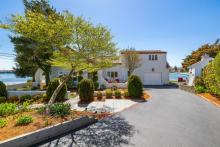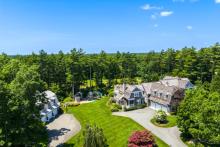Spragues Cove Stormwater Remediation Project update
The Spragues Cove Stormwater Remediation Project was constructed during the period of February to June of 1995. There is a history of funding of the project that is not necessary to summarize here other than to note that it was difficult and volunteer work contributed to its accomplishment. The town of Marion, the Buzzards Bay Project, and the Plymouth Conservation District were all involved in the project.
The construction plans and specification were provided by the U.S. Department of Agriculture Soil Conservation Service. The purpose of the project was to treat the stormwater discharge to reduce the fecal coliform levels going into Spragues Cove.
The focus of this discussion is on the Operation and Maintenance (O&M) of the completed project. The USDA, Soil Conservation Service project description document (dated August 1992) contained a two paragraph section addressing O&M.
The first paragraph contained general guidance with respect to storm damage, malfunctions, and replacement of vegetation if needed. The second paragraph contained more specific instructions:
“Both long and short-term inspection and maintenance of the system is the primary responsibility of the Marion Conservation Commission. Any noxious vegetation that threatens the plant diversity within the wetlands (ex. Phagmites and purple loosestrife) must be controlled.
Also, accumulation of sediment and other debris in the sediment basins, the storm drain pipe, and the outlet pipes and channel must be removed at least once per year or more frequently, if needed.”
The Notice of Intent (SE41-556) submitted by the Town contained in the Appendix A (Special Conditions) an item that read:
“Operation and maintenance of the system shall comply with the Spragues Cove Stormwater Remediation Project Operation and Maintenance Plan that was submitted with the Notice of Intent."
The Spragues Cove Stormwater Remediation Project Operation and Maintenance Plan required periodic inspection of the physical aspects of the project and viability of the included plants. Damage should be repaired to original specifications.
Other maintenance items included; (1) maintain fence or other barrier between parking lot and wetland, (2) mow detention basin on the same schedule as surrounding recreational land, (3) remove accumulated sediment from sediment basin, storm drains and detention areas, (4) keep deep pool stocked with indigenous fish, crayfish and freshwater clams/mussels, and (5) control algae and mosquitoes as much as possible with biological control.
In the Spring of 2007, the Marion Department of Public Works (DPW) cut down a large section of Japanese Knotweed (invasive species) in the Northeast corner of the perimeter dike. This resulted in the Conservation Commission receiving a call about cutting in wetlands and a letter identifying potential damage to turtle habitat.
At that time we requested DPW to cease the cutting, performed a site visit, and researched the historical paperwork. The end result was the development of a revised and more detailed Spragues Cove Stormwater Remediation Project Operation and Maintenance Plan that was co-signed in March of 2007 by both the Conservation Commission and DPW.
During the summer of 2010, various residents adjacent to the Spragues Cove project approached the Selectmen and the Conservation Commission with respect to removing trees from the project site.
Subsequently, the Tree and Parks Committee has contacted the Conservation Commission with a proposal to continue the existing path all around the perimeter dike, remove some underbrush, and remove the deteriorating split rail fence and replace it with plantings. The Tree and Parks Committee has talked to the abutters and the DPW.
At the time of the 2007 inspection there was already Phragmites present throughout the site. The previously mentioned Japanese Knotweed remains as well as Oriental Bittersweet, all invasive species.
Willow trees had established a dense border on the internal side of the periphery dike and all along the finger dikes. It was immediately obvious during 2010 visits that the Phragmites are totally out of control creating an almost impenetrable mass of growth and an extensive visual barrier. The willow growth was also overwhelming.
The Project is now 17 years old. Prior to the 2007 annual inspection by the Conservation Commission it appears that little O&M was accomplished. DPW had attempted to keep a walking area open but over time that was becoming more difficult.
Necessary maintenance of this project has not been actively pursued. This may be attributed to rotation of personnel, the belief that it will take care of itself, the fact that the changes have been gradual over the years, and other overriding financial factors.
We were faced with an extensive, potentially expensive effort to determine exactly what condition the site is in and to determine what actions are necessary to recover from the neglect.
Initial actions during the week of 23 July seemed radical but are the first steps to return the project to its intended condition. These actions included mowing the phragmites and other invasive species on the top and both sides of the periphery of the project.
The willow trees were removed from the majority of the internal sides of the periphery dike. Regular mowing of these areas will be necessary going forward to prevent the resurgence of the invasive species. We still have to determine the extent of willow tree removal from the finger dikes. That effort will have to be accomplished by hand when a decision is made.
Some actions remain to be accomplished. The condition of the three pools in the project has still to be determined; we do not know to what extent they have been silted up in the intervening 17 years. As chemical testing of the output of the project has not been ongoing, we still have to determine if it is functioning as designed.
The Conservation Commission, theTree/Parks Committee, the Recreation Committee, and the DPW are working together along with the Friends of Silvershell Beach to restore the Spragues Cove Stormwater Remediation Project to its intended condition and functionality.
Norman A. Hills, Clerk
Marion Conservation Commission
July 30, 2012












